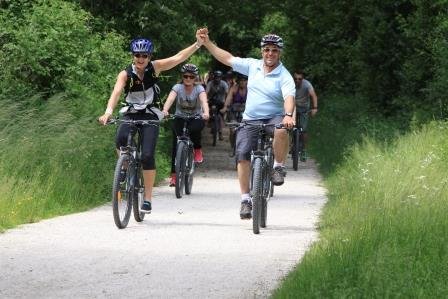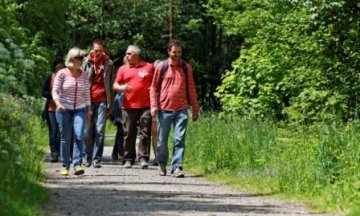Case Study
‘Bienvenus les sportifs’ Project – Natura 2000 Site – European Commission Prize
Contact name
Gerald Duhayon, Assistant director
Institution name
Scarpe-Escaut Regional Natural Park
Region & country
Nord, France
Summary
The title of the project could be translated into “Athletes, feel welcome!” The idea emerged from the many contacts we have with the organisers of sporting events: we receive correspondence very regularly regarding the issues at stake in the sites they use – and we explain the impact assessment and the requirements they have to meet.
However, we found that in most cases, they did not understand the constraints which appeared with the designation of the sites: therefore, they did not really endorsed them and failed to implement them efficiently. For example, the organisers of an annual race, which has existed since 1984, were faced with misunderstanding on the part of their staff. As this race takes place in the back season, when biodiversity is less apparent, they just could not figure out that the race could have an impact nor understand why they should adapt their organisation. Therefore, they asked us to sensitise their staff. We thought that in order to support these efforts from the organising teams, it would be useful to communicate directly to the sports community at the events. By making athletes better understand the biodiversity challenges, the potential impacts of their practices and the requirements related to appropriate assessments, we would contribute to making them more acceptable and therefore better implemented.




Background of the project
How was the situation previous to your actions?
Basically there was no prior control of the actions, and above all there was no effective information and communication system, so that the restrictions carried out or the requirements demanded of the sports organisers were not successful as the reasons were not understood, leading to disagreements between the organisers and the park. It was later discovered that the events had been carried out without the respect of the necessary administrative actions.
What were the needs you identified?
In general, respect Natura 2000 sites and disseminate respectful practices so that these practices can endure: promote and support the implementation of concrete actions for the preservation, management and restoration of Natura 2000 habitats and species by the local landowners and land-users.
More specifically about land uses and outdoor sports, the first need identified was the need for dialogue, the need to accompany sports event developers so that all the staff could efficiently understand the need to regulate and control events based on criteria of respect for the biodiversity present in the protected area. This has therefore been the main objective from the beginning of the project: to guide.
Finally, the need to reach different actors involved was also raised, such as sports clubs/federations, with special attention to the MTBs, so that they could carry out the task of raising awareness among their members, in such a way that the message of respect and environmental protection would reach any participant.
Solution and actions taken
What solution you found to cover those needs?
- Meetings with sports associations, both trekking and mountain bike, informing them about the administrative procedures, as well as the possibilities of accompaniment and guidance, but above all explaining the reason for the prohibitions or requirements, so that they are not unilateral impositions. For example, a species of bird that nests on the ground, if a sports tour is organised near these areas, will cause enormous damage from the point of view of biodiversity.
- Effectively communicate the message in any type of sports event. Thus, a 3m length panel is installed, where on one side the sensitive species linked to the Natura2000 site and their ecological requirements are shown, and on the other side the testimonies of the presidents of different sports clubs (MTB, trekking and runing) addressing their members. This is a tool made available to sports organisers so that they can raise awareness among participants.
Panel pictures:


What actions did you take to reach the solution?
The main action was the implementation of an accident assessment system for Natura 2000 sites. This allows an evaluation of the possible damage to nature that can be caused by athletes during the development of the competition or any type of event. It is a requirement which is added to the other authorisations granted by the public administration to event organisers. Even if this system is planned for events with more than 300 participants, one of the positive aspects is that events that do not exceed that number have also decided to carry out the procedure in such a way that negative externalities are kept to a minimum.
In addition, the park has designated 2 ”Natura2000 Animators’‘ both biologists, who are responsible for ensuring that procedures are respected in the organization of sporting events, as well as in the task of accompanying and communicating the message of respect for biodiversity.
Other institutions or parties involved
- Any organizer of sports events with an interest in holding a competition or event of similar characteristics within the territory defined as a Natura2000 site.
- Also amateur clubs of MTB, trekking or other related outdoor sports.
- Partnership with the national forest office for the analysis of public forest frequentation.
Results
Over time, some of the clubs that pioneered this initiative, showing a total commitment, went so far as to request a second panel, and after verification by the ‘N2000 facilitators’, they found that the clubs had a person in charge of the relevant explanation about the species and risks at the beginning of each activity.
Now, all the sport organizers accept the game, they make the request by the established procedures understanding that the people in charge of the N2000 site have an open attitude and not of total prohibition, even postponing the dates of some events to a more suitable period according to the demands of the biodiversity. It is therefore a mutual commitment, not to ban sports activities, but to adapt them to the best conditions to reduce the impact on ecosystems.
Challenges
- To be improved: one of the points would be the development of a system for evaluating and measuring frequentation. The fact that the constant frequency of users on the roads can create more impact than the punctual participants of a specific event, reveals the need to create an adequate measurement system.
- Another important aspect when assessing the damage created to biodiversity is the intrinsic characteristics of the protected area. In those cases where a specific trail is identified for a species, it is easier, but when a large number of trails and species are involved, the conclusions are blurred. The cause-effect relationship is difficult to state with total certainty in these cases.
Lessons learned
‘‘In order to practice outdoor sports, we all want to enjoy beautiful nature, but in order to have it, we must first respect it.’’
Contact name
Gerald Duhayon, Assistant director
Institution name
Scarpe-Escaut Regional Natural Park
Website(s)
